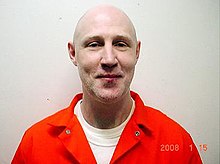Ronnie Lee Gardner | |
|---|---|
 Gardner in 2008 | |
| Born | January 16, 1961 |
| Died | June 18, 2010 (aged 49) |
| Cause of death | Execution by firing squad |
| Occupation(s) | Criminal, thief |
| Criminal status | Executed |
| Children | 2[4] |
| Parent(s) | Dan Gardner Ruth Gardner Lucas[5] |
| Motive | |
| Conviction(s) | Robbery – February 1980[1] Burglary, escape – 1981[2] Murder – June 1985 Capital murder – October 22, 1985[1] |
| Criminal penalty | Death |
| Details | |
| Victims | Melvyn John Otterstrom, 37 Michael Burdell, 36 |
| Date | October 9, 1984 April 2, 1985 |
| Country | United States |
| State(s) | Utah |
Ronnie Lee Gardner (January 16, 1961 – June 18, 2010) was an American criminal who received the death penalty for killing a man during an attempted escape from a courthouse in 1985, and was executed by a firing squad by the state of Utah in 2010. His case spent nearly 25 years in the court system, prompting the Utah House of Representatives to introduce legislation to limit the number of appeals in capital cases.[6]
In October 1984, Gardner killed Melvyn John Otterstrom, 37, during a robbery in Salt Lake City. While being moved in April 1985 to a court hearing for the homicide, he fatally shot attorney Michael Burdell, 36, in an unsuccessful escape attempt. Convicted of two counts of murder, Gardner was sentenced to life imprisonment for the first charge and received the death penalty for the second charge.[1][2] The state adopted more stringent security measures as a result of the incident at the courthouse.[7] While held at Utah State Prison, Gardner was charged with another capital crime for stabbing an inmate in 1994. However, that charge was discarded by the Utah Supreme Court because the victim survived.[1]
In a series of appeals, defense attorneys presented mitigating evidence of the troubled upbringing of Gardner, who had spent nearly his entire adult life in incarceration.[1] His request for commutation of his death sentence was denied in 2010 after the families of his victims testified against him.[8][9] Gardner's legal team took the case to the United States Supreme Court, which declined to intervene.[10]
The execution of Gardner at Utah State Prison became the focus of media attention in 2010 because it was the first to be carried out by firing squad in the U.S. in 14 years.[11] Gardner stated that he sought this method of execution because of his Mormon background.[12] On the day before his execution, the Church of Jesus Christ of Latter-day Saints released a statement clarifying its position on the issue of blood atonement of individuals.[13] The case also attracted debate over capital punishment and whether Gardner had been destined for a life of violence since his difficult childhood.[14]
- ^ a b c d e f Carlisle, Nate (2010-06-14). "Ronnie Lee Gardner: A dark and deadly path". The Salt Lake Tribune. Archived from the original on 2016-08-16. Retrieved 2010-06-22.
- ^ a b "Convict Shoots Way Out Of Courthouse". The Gadsden Times. Associated Press. 1985-04-02. p. A2. Retrieved 2010-09-25.
- ^ Cite error: The named reference
DailyTelegraph-20100618-executedwas invoked but never defined (see the help page). - ^ Cite error: The named reference
SLT-20100617-goodbyewas invoked but never defined (see the help page). - ^ Cite error: The named reference
Deseret-20100612-punishmentwas invoked but never defined (see the help page). - ^ Romboy, Dennis (2010-10-20). "Utah lawmaker aims to limit death-row inmate appeals". Deseret News. Archived from the original on 2024-01-21. Retrieved 2010-10-24.
- ^ Reavy, Pat (2010-06-15). "Security scarce at courthouse when Ronnie Lee Gardner murdered attorney". Deseret News. Archived from the original on 2024-01-21. Retrieved 2010-10-01.
- ^ Falk, Aaron (2010-06-14). "Parole board, Supreme Court both reject Ronnie Lee Gardner's latest pleas". Deseret News. Archived from the original on 2024-01-21. Retrieved 2010-09-30.
- ^ Adams, Andrew (2010-06-17). "Impending execution generates range of emotions". KSL-TV. Archived from the original on 2010-06-21. Retrieved 2010-10-24.
- ^ Dobner, Jennifer (2010-06-17). "Utah firing squad ready to go as appeals appear to fail". The Seattle Times. Associated Press. Archived from the original on 2010-06-21. Retrieved 2010-06-18.
- ^ "Utah firing squad executes US killer Ronnie Lee Gardner". BBC News. 2010-06-18. Archived from the original on 2010-07-19. Retrieved 2010-06-22.
- ^ Donaldson, Amy (1996-02-09). "Inmate threatens to sue if state won't let him die by firing squad". Deseret News. Archived from the original on 2024-01-21. Retrieved 2010-09-25.
- ^ The Church of Jesus Christ of Latter-day Saints (2010-06-17). "Mormon church statement on blood atonement". Deseret News. Archived from the original on 2010-08-26. Retrieved 2010-09-25.
- ^ Reid, Stuart (2010-08-09). "Cardinal O'Brien is right: there is a vengeance culture in the US". The Catholic Herald. Archived from the original on 2010-08-17. Retrieved 2010-08-09.